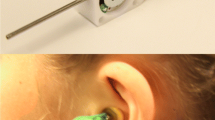Abstract
A new probe, N-1, for EOAE measurement has been designed by utilizing the compartment of a behind-the-ear type hearing and containing the microphone power source. The probe features an aluminium holder connected to a microphone and an earphone with two acoustic holes bored into the probe tip metal plane and covered with a plastic earplug. As a result, barreled tubing is not utilized.
The frequency characteristic of earphone was within 5 dB between 150 Hz and 4 kHz. The frequency characteristic curve of the microphone varied within 10 dB from 150 Hz to 9 kHz. The probe has a total weight of only 13.5g. The holding system fits snugly and securely into external auditory canal allowing for EOAE examination in sitting position. It is also feasible for EOAE examination in a soundproof room for single-person use and in out-patient clinics.
Similar content being viewed by others
References
Bray, P. and Kemp D.T. (1987): An advanced cochlear echo technique suitable for infant screening.Brit. J. Audiol 21 : 191–204.
Dallos, P. (1973): The auditory periphery, New York San Francisco London,Academic Press Inc., 23–117.
Gibson, W.P.R. (1978): Essentials of clinical electric response audiometry, Edinburgh London and New York,churchill Livingstone, 59–106.
Kemp., D.T. (1978): Stimulated acoustic emissions from within the human auditory system.J. Acoust. Soc. Am 64: 1386–1391.
Kemp, D.T., Ryan S. and Bray P. (1990): A guide to the effective use of otoacoustic emissions.Ear and Hear 11 : 93–105.
Koseki, Y, Tanaka, Y, O-uchi, T. and Itoh, H. (1987): Acoustic probes for stimulated oto-acoustic emission.Ear. Res. Jpn 18: 381–383.
Nishida, H. (1981): Clinical application of Electrocochleography.Practica Otologica (Kyoto) 74 : 134–138.
Nishida, H. Tanaka, Y, Okada, M., Inoue, Y (1995): Evoked otoacoustic emissions and Electrocochleography in a patient with multiple otosclerosis.Ann Otol Rhinol Laryngol 104: 456–462.
Nishikawa N., Ase Y, Machiki K., Takahashi K., Kusakari J. (1990): The acoustic properties of measuring probes for evoked acoustic emission.Audiology Japan 33: 105–109
Olson H.F. (1957): Acoustical engineering, New Jersey Toronto London New York,D. Van Nostrand Company Inc, 96–105.
Tanaka, Y, Suzuki, M. and Inoue, T. (1990): Evoked otoacoustic emission in sensorineural impairment : Its clinical implications. Ear and Hearing.Ear Hear 11: 134–143.
Author information
Authors and Affiliations
Rights and permissions
About this article
Cite this article
Nishida, H. A new acoustic probe (N-1) for EOAE measurement. IJO & HNS 48, 104–109 (1996). https://doi.org/10.1007/BF03048054
Issue Date:
DOI: https://doi.org/10.1007/BF03048054




